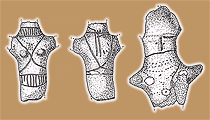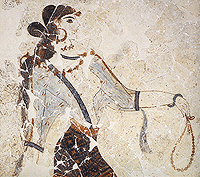There is little evidence on the dressing of the inhabitants of the Aegean islands before the Late Bronze Age. The Cycladic figurines of the Early Bronze Age are naked while the colour preserved on some of them can be interpreted as the painting of the skin or tattoo marks. The only relevant indications come from a group of figurines from Thermi on Lesbos which present details in their clothes. But even these are fairly abstract. Therefore we cannot form a clear image of the clothes. Conversely, from the Late Cycladic period the frescoes of Thera and the Mycenaean type figurines, that is the works of two representational arts, which were diffused on the Aegean islands respectively from Crete and Mycenaean Greece provide considerable information on the dressing of the islanders. The fresco representations show that the inhabitants of Thera followed the Minoan fashion, as the very elegant female costumes which are known from Crete appear on these frescoes. These costumes were composed of wide bell-shaped skirts made of successive woven bands and a tight-fitting bodice leaving the breasts exposed. The ends of the clothes were, as the Minoan ones, decorated with elaborately woven bands. The very fine transparent clothes which, according to one view, were made of silk materials, is a trait of female dressing considered as regional, since it does not occur in the dressing of Crete. This was recently supported by the discovery of silkworm cocoons in the excavations at Akrotiri. The female costume was accompanied by many jewellery (necklaces, bracelets, earrings) made of precious metals and colourful stones which observed strictly the Minoan style and design. The impressive appearance of the women was completed by the painting of the eyes and face, and tattoo marks. However, these elements may have been traits of priestesses only. Most of the representations in which human figures are depicted are religious. Therefore, these costumes may not represent everyday clothes but ritual priestly vestments. The "miniature frieze" in which may persons of different properties are illustrated, is an exception. In this fresco the female clothes are all quite similar while the men's clothes are distinguished in different types which express presumably social differences. The Minoan style loincloth was worn mostly by men that were occupied with an activity of movement. The men taking part in ritual acts wore a simple garment which did not differ greatly from that of the shepherds. The clay figurines Fi and Psi of the sanctuaries at Agia Irini and Phylakopi, as well as the large-sized hollow-bodied figurines of these sanctuaries reveal a completely different dressing tradition. These figurines wear only a long sleeved garment, which is frequently decorated with complex woven patterns, worn also by Mycenaean figurines. |
 |
|
|
Lesbos, Thermi. Clay female figurines.
|
||
 |
||
|
Thera, Akrotiri-Xeste 3. Detail
from the "Adorants Fresco". |
||
 |
||
|
Melos, Phylakopi. Clay figurine -
The "Lady of Phylakopi". |
||